Mathilde Boumasmoud
@mboum.bsky.social
Postdoc at @ETH_en 👩🏽🔬👩🏽💻 🧐
Microbial evolution | Human microbiome ecology | Infectious disease epidemiology
Microbial evolution | Human microbiome ecology | Infectious disease epidemiology
Reposted by Mathilde Boumasmoud
Our paper “Global dissemination of npmA mediated pan‑aminoglycoside resistance via a mobile element in Gram‑positive bacteria” is now in @natcomms.nature.com. Part of my freshly defended PhD, so doubly happy! 😄🎉
🧵 (1/14)
www.doi.org/10.1038/s414...
🧵 (1/14)
www.doi.org/10.1038/s414...
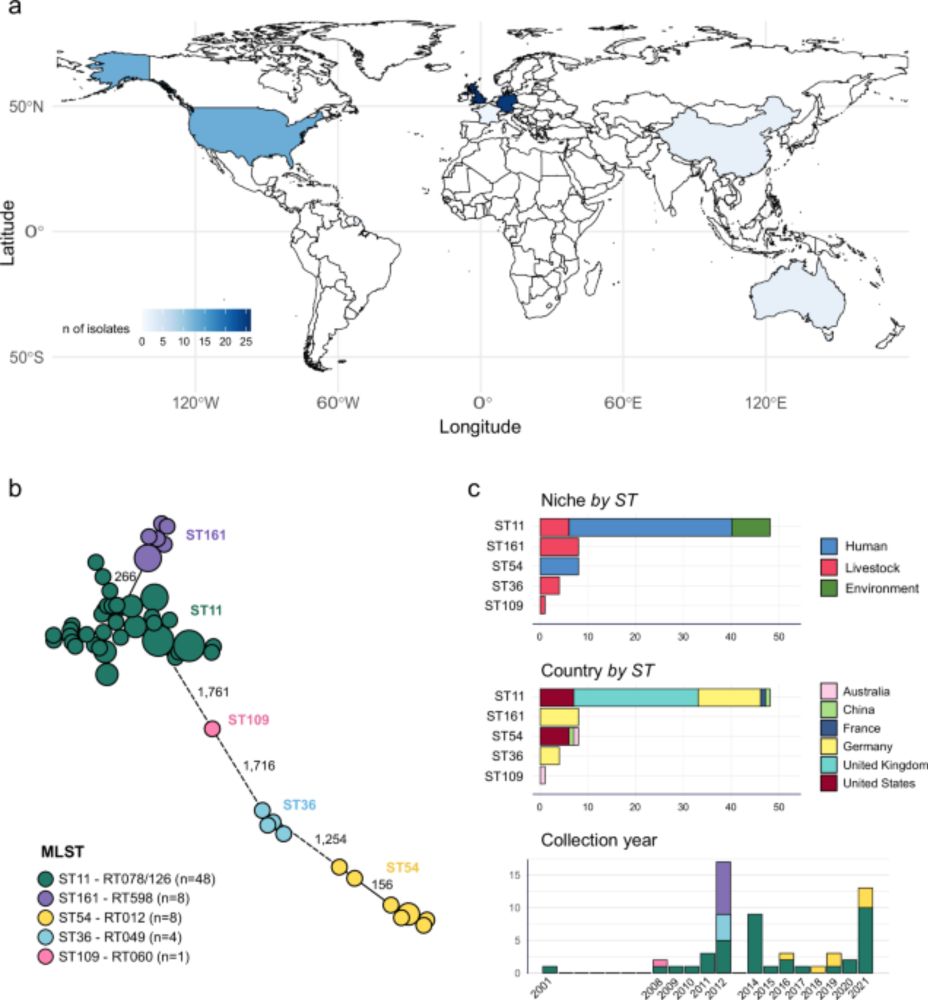
Global dissemination of npmA mediated pan-aminoglycoside resistance via a mobile genetic element in Gram-positive bacteria - Nature Communications
The authors investigate the distribution of the aminoglycoside resistance gene npmA in Gram-positive bacteria via a mobile genetic element, highlighting its global presence and cross-species transfer ...
www.doi.org
July 17, 2025 at 12:13 PM
Our paper “Global dissemination of npmA mediated pan‑aminoglycoside resistance via a mobile element in Gram‑positive bacteria” is now in @natcomms.nature.com. Part of my freshly defended PhD, so doubly happy! 😄🎉
🧵 (1/14)
www.doi.org/10.1038/s414...
🧵 (1/14)
www.doi.org/10.1038/s414...
Reposted by Mathilde Boumasmoud
Can we leverage bacterial competition for targeted replacement of harmful strains? Maybe! Our recent piece in @natmicrobiol.nature.com provides a theoretical framework and a set of experiments to show what it might take: www.nature.com/articles/s41...

Strain displacement in microbiomes via ecological competition - Nature Microbiology
Mathematical modelling and experimental tests reveal principles that govern displacement of a resident strain by an invader in microbial communities.
www.nature.com
November 7, 2025 at 10:34 PM
Can we leverage bacterial competition for targeted replacement of harmful strains? Maybe! Our recent piece in @natmicrobiol.nature.com provides a theoretical framework and a set of experiments to show what it might take: www.nature.com/articles/s41...
New paper out 🎆 When an antibiotic-resistant E. coli strain lands in our gut microbiome, whether it will get established or not depends on the ecological context. We studied how other microbes, nutrients, and antibiotic exposure shape its fate.👇
🚨 Excited to share our new paper is out! 🎉
We show how interactions within gut microbiomes allow certain antibiotic-resistant E. coli strains to persist even without antibiotics, helping explain how resistance is maintained in the human gut.
Now published in @natcomms.nature.com rdcu.be/eOf63
We show how interactions within gut microbiomes allow certain antibiotic-resistant E. coli strains to persist even without antibiotics, helping explain how resistance is maintained in the human gut.
Now published in @natcomms.nature.com rdcu.be/eOf63

Multi-layered ecological interactions determine growth of clinical antibiotic-resistant strains within human microbiomes
Nature Communications - The role of ecological factors in modulating the spread of antibiotic-resistance bacteria in the gut remains unclear. Here, the authors use anaerobic microcosms to study the...
rdcu.be
November 9, 2025 at 9:34 PM
New paper out 🎆 When an antibiotic-resistant E. coli strain lands in our gut microbiome, whether it will get established or not depends on the ecological context. We studied how other microbes, nutrients, and antibiotic exposure shape its fate.👇
Reposted by Mathilde Boumasmoud
So happy to share this! Bacteriocins were first discovered over 100 years ago, but what do they actually do? We look at >1000 bacteriocin plasmids and find links to virulence and antimicrobial resistance, and frequent bacteriocin sharing in Enterobacteriaceae.
www.nature.com/articles/s41...
www.nature.com/articles/s41...

Bacterial warfare is associated with virulence and antimicrobial resistance - Nature Communications
Bacteria employ a range of competition systems that deliver toxins to inhibit competing strains. This study shows that these systems are particularly important for the ecology of virulent and antibiot...
www.nature.com
November 5, 2025 at 7:32 AM
So happy to share this! Bacteriocins were first discovered over 100 years ago, but what do they actually do? We look at >1000 bacteriocin plasmids and find links to virulence and antimicrobial resistance, and frequent bacteriocin sharing in Enterobacteriaceae.
www.nature.com/articles/s41...
www.nature.com/articles/s41...
Reposted by Mathilde Boumasmoud
🐝🦠 New paper: rdcu.be/eOf7A
Phages may drive microbial diversity, yet we often don’t even know how phages & bacteria correlate in nature. Our new study tackles this in the honeybee gut, thanks to the great work of PhD student @malickndiaye.bsky.social at @dmf-unil.bsky.social @fbm-unil.bsky.social
Phages may drive microbial diversity, yet we often don’t even know how phages & bacteria correlate in nature. Our new study tackles this in the honeybee gut, thanks to the great work of PhD student @malickndiaye.bsky.social at @dmf-unil.bsky.social @fbm-unil.bsky.social

Phage diversity mirrors bacterial strain diversity in the honey bee gut microbiota - Nature Communications
Authors analyse paired viral and bacterial shotgun metagenomics data from individual honeybee guts, revealing modular, nested phage–bacteria networks, with viral diversity mirroring bacterial strain c...
www.nature.com
November 4, 2025 at 8:36 PM
🐝🦠 New paper: rdcu.be/eOf7A
Phages may drive microbial diversity, yet we often don’t even know how phages & bacteria correlate in nature. Our new study tackles this in the honeybee gut, thanks to the great work of PhD student @malickndiaye.bsky.social at @dmf-unil.bsky.social @fbm-unil.bsky.social
Phages may drive microbial diversity, yet we often don’t even know how phages & bacteria correlate in nature. Our new study tackles this in the honeybee gut, thanks to the great work of PhD student @malickndiaye.bsky.social at @dmf-unil.bsky.social @fbm-unil.bsky.social
Reposted by Mathilde Boumasmoud
New(ish!) paper on how within-host competition and antibiotic resistance shape the fitness of Streptococcus pneumoniae serotypes, out in August in Plos Biology. journals.plos.org/plosbiology/...

Quantifying the effects of antibiotic resistance and within-host competition on strain fitness in Streptococcus pneumoniae
Competition significantly influences bacterial population dynamics, particularly in how strains interact within and between hosts. This study shows that within-host competition in Streptococcus pneumo...
journals.plos.org
October 31, 2025 at 3:05 PM
New(ish!) paper on how within-host competition and antibiotic resistance shape the fitness of Streptococcus pneumoniae serotypes, out in August in Plos Biology. journals.plos.org/plosbiology/...
Reposted by Mathilde Boumasmoud
So excited to share a new paper from my lab just published in Nature Communications! We showed that vancomycin-resistant enterococci (VRE) occupied distinct intestinal niches in the antibiotic-treated intestine. doi.org/10.1038/s414... Amazing work by first author Olivia King and colleagues!

Vancomycin-resistant enterococci utilise antibiotic-enriched nutrients for intestinal colonisation - Nature Communications
Here, the authors show that vancomycin-resistant enterococci grow in the antibiotic-treated gut microbiome by utilising enriched nutrients in the presence of reduced concentrations of inhibitory micro...
doi.org
July 14, 2025 at 9:11 AM
So excited to share a new paper from my lab just published in Nature Communications! We showed that vancomycin-resistant enterococci (VRE) occupied distinct intestinal niches in the antibiotic-treated intestine. doi.org/10.1038/s414... Amazing work by first author Olivia King and colleagues!
Reposted by Mathilde Boumasmoud
OUT NOW - Long-read metagenomics method for strain tracking after FMT #microsky www.nature.com/articles/s41...

Long-read metagenomics for strain tracking after faecal microbiota transplant - Nature Microbiology
A long-read metagenomics method empowers faecal microbiota transplantation studies by precisely tracking bacteria from donors to recipients, distinguishing co-existing strains and revealing genomic ch...
www.nature.com
October 23, 2025 at 12:59 PM
OUT NOW - Long-read metagenomics method for strain tracking after FMT #microsky www.nature.com/articles/s41...
Reposted by Mathilde Boumasmoud
Deciphering microbial spatial organization: insights from synthetic and engineered communities url: academic.oup.com/ismecommun/a...

Deciphering microbial spatial organization: insights from synthetic and engineered communities
Abstract. Microbial communities are frequently organized into complex spatial structures, shaped by intrinsic cellular traits, interactions between communi
academic.oup.com
September 10, 2025 at 7:45 PM
Deciphering microbial spatial organization: insights from synthetic and engineered communities url: academic.oup.com/ismecommun/a...
Reposted by Mathilde Boumasmoud
Our high-precision metagenomic strain caller, PHLAME, is now published in Cell Reports!! www.cell.com/cell-reports...
PHLAME works on tough sample types -- including those with coexisting strains of a species and low depth.
PHLAME works on tough sample types -- including those with coexisting strains of a species and low depth.
August 15, 2025 at 4:33 PM
Our high-precision metagenomic strain caller, PHLAME, is now published in Cell Reports!! www.cell.com/cell-reports...
PHLAME works on tough sample types -- including those with coexisting strains of a species and low depth.
PHLAME works on tough sample types -- including those with coexisting strains of a species and low depth.
Reposted by Mathilde Boumasmoud
Deriving ecological models solely from observational data limits our ability to understand mechanisms driving microbiome assembly. This #mSystems articles explores how experimental approaches can address these challenges. asm.social/2wj

July 30, 2025 at 3:26 PM
Deriving ecological models solely from observational data limits our ability to understand mechanisms driving microbiome assembly. This #mSystems articles explores how experimental approaches can address these challenges. asm.social/2wj
Reposted by Mathilde Boumasmoud
#Review
A discussion on the processes driving bacterial evolution and emergence of pathogenesis within hosts, the importance of understanding within-host genetic diversity, and the implications for transmission analysis and infectious disease control.
#MicroSky 🦠
www.nature.com/articles/s41...
A discussion on the processes driving bacterial evolution and emergence of pathogenesis within hosts, the importance of understanding within-host genetic diversity, and the implications for transmission analysis and infectious disease control.
#MicroSky 🦠
www.nature.com/articles/s41...
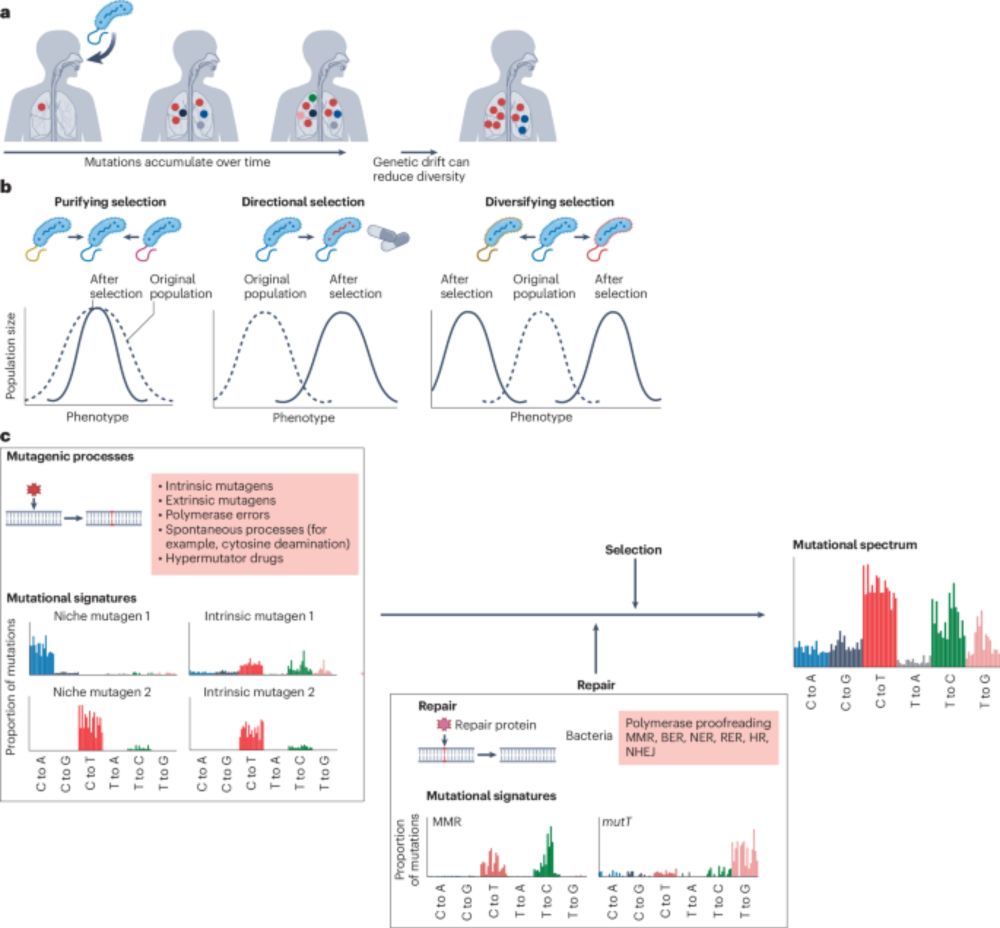
Within-host bacterial evolution and the emergence of pathogenicity - Nature Microbiology
In this Review, Tonkin-Hill et al. discuss the processes driving bacterial evolution and emergence of pathogenesis within hosts, the importance of understanding within-host genetic diversity, and the ...
www.nature.com
July 30, 2025 at 3:40 PM
#Review
A discussion on the processes driving bacterial evolution and emergence of pathogenesis within hosts, the importance of understanding within-host genetic diversity, and the implications for transmission analysis and infectious disease control.
#MicroSky 🦠
www.nature.com/articles/s41...
A discussion on the processes driving bacterial evolution and emergence of pathogenesis within hosts, the importance of understanding within-host genetic diversity, and the implications for transmission analysis and infectious disease control.
#MicroSky 🦠
www.nature.com/articles/s41...
Reposted by Mathilde Boumasmoud
Our paper demonstrating that within-species warfare interactions are ecologically important on human skin is now published in Nature Micro! www.nature.com/articles/s41...
June 30, 2025 at 12:26 PM
Our paper demonstrating that within-species warfare interactions are ecologically important on human skin is now published in Nature Micro! www.nature.com/articles/s41...
This is such a cool read on the fascinating topic of nutrient competition in microbiomes😍 I couldn t agree more with «A key challenge in understanding microbiomes is that the species composition often differs among individuals, which can thwart generalization. »
Please read about how we think microbial metabolism might help us understand microbiomes a bit better!
Also, please appreciate the mountain goat in Fig 1 ⛰️🐐 and that it also represents my joy for trail running and the mountains 😁
Also, please appreciate the mountain goat in Fig 1 ⛰️🐐 and that it also represents my joy for trail running and the mountains 😁
Metabolic ecology of microbiomes: Nutrient competition, host benefits, and community engineering
Review by Erik Bakkeren, Vit Piskovsky, and Kevin R. Foster
www.cell.com/cell-host-mi...
Review by Erik Bakkeren, Vit Piskovsky, and Kevin R. Foster
www.cell.com/cell-host-mi...
June 13, 2025 at 8:19 PM
This is such a cool read on the fascinating topic of nutrient competition in microbiomes😍 I couldn t agree more with «A key challenge in understanding microbiomes is that the species composition often differs among individuals, which can thwart generalization. »
Reposted by Mathilde Boumasmoud
Our work on the facial skin microbiome of non-human primates is out in mSystems!
We show there is no close relative of Cutibacterium on the faces of gorillas and chimps at the Lincoln Park Zoo, furthering the mysterious origin of the dominant human skin colonizer.
journals.asm.org/doi/10.1128/...
We show there is no close relative of Cutibacterium on the faces of gorillas and chimps at the Lincoln Park Zoo, furthering the mysterious origin of the dominant human skin colonizer.
journals.asm.org/doi/10.1128/...
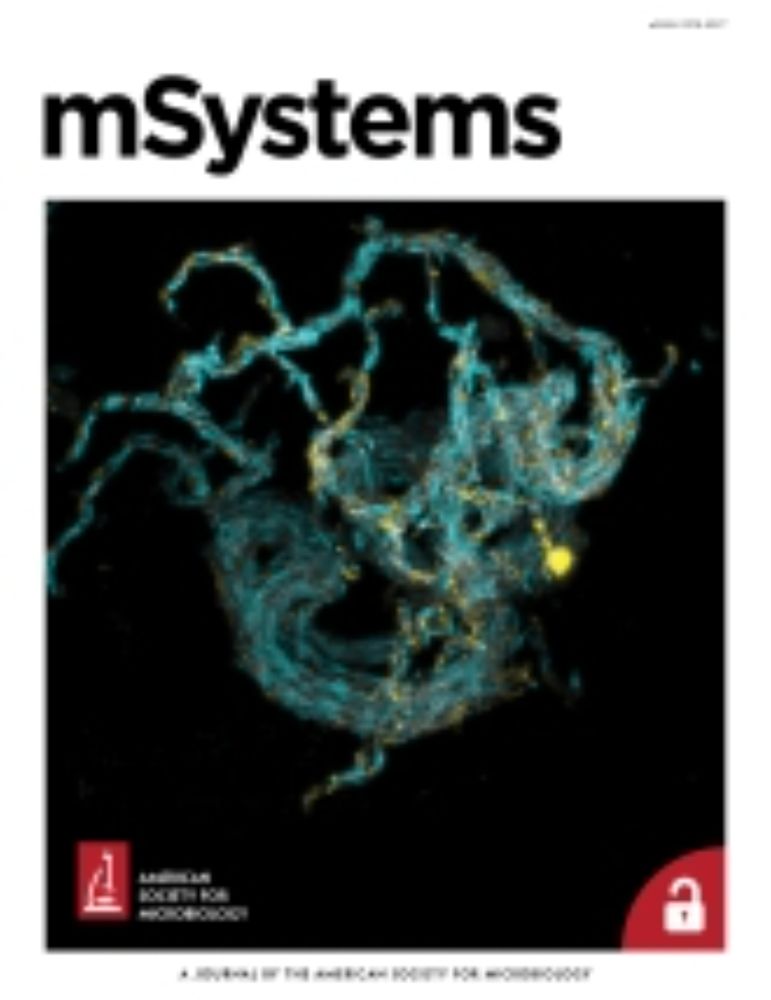
The microbiome of the human facial skin is unique compared to that of other hominids | mSystems
Understanding how and why human skin bacteria differ from our closest animal relatives
provides crucial insights into human evolution and health. While we have known that
human facial skin hosts disti...
journals.asm.org
May 30, 2025 at 12:14 PM
Our work on the facial skin microbiome of non-human primates is out in mSystems!
We show there is no close relative of Cutibacterium on the faces of gorillas and chimps at the Lincoln Park Zoo, furthering the mysterious origin of the dominant human skin colonizer.
journals.asm.org/doi/10.1128/...
We show there is no close relative of Cutibacterium on the faces of gorillas and chimps at the Lincoln Park Zoo, furthering the mysterious origin of the dominant human skin colonizer.
journals.asm.org/doi/10.1128/...
Reposted by Mathilde Boumasmoud
ICYMI: CRISPR–Cas therapies targeting bacteria

CRISPR–Cas therapies targeting bacteria
Nature Reviews Bioengineering, Published online: 13 May 2025; doi:10.1038/s44222-025-00311-8CRISPR–Cas tools can be designed to kill or modify specific bacteria. This Review explores the engineering of CRISPR–Cas tools and corresponding delivery strategies for the treatment of bacterial infections and modification of the microbiome.
www.nature.com
May 15, 2025 at 6:53 AM
Reposted by Mathilde Boumasmoud
Thrilled to share that our manuscript on strain-level gut microbiome variation across diverse populations and human phenotypes is out today in @cellpress.bsky.social
Curious about how strain diversity relates to human traits? Follow this thread! 🌍 (1/n)
www.sciencedirect.com/science/arti...
Curious about how strain diversity relates to human traits? Follow this thread! 🌍 (1/n)
www.sciencedirect.com/science/arti...

Global genetic structure of human gut microbiome species is related to geographic location and host health
The human gut harbors thousands of microbial species, each exhibiting significant inter-individual genetic variability. Although many studies have ass…
www.sciencedirect.com
April 30, 2025 at 4:15 PM
Thrilled to share that our manuscript on strain-level gut microbiome variation across diverse populations and human phenotypes is out today in @cellpress.bsky.social
Curious about how strain diversity relates to human traits? Follow this thread! 🌍 (1/n)
www.sciencedirect.com/science/arti...
Curious about how strain diversity relates to human traits? Follow this thread! 🌍 (1/n)
www.sciencedirect.com/science/arti...
Reposted by Mathilde Boumasmoud
Excited to share our latest, out today in @naturemicrobiol.bsky.social Bacteriocin production facilitates nosocomial emergence of vancomycin-resistant Enterococcus faecium www.nature.com/articles/s41... @idpittstop.bsky.social
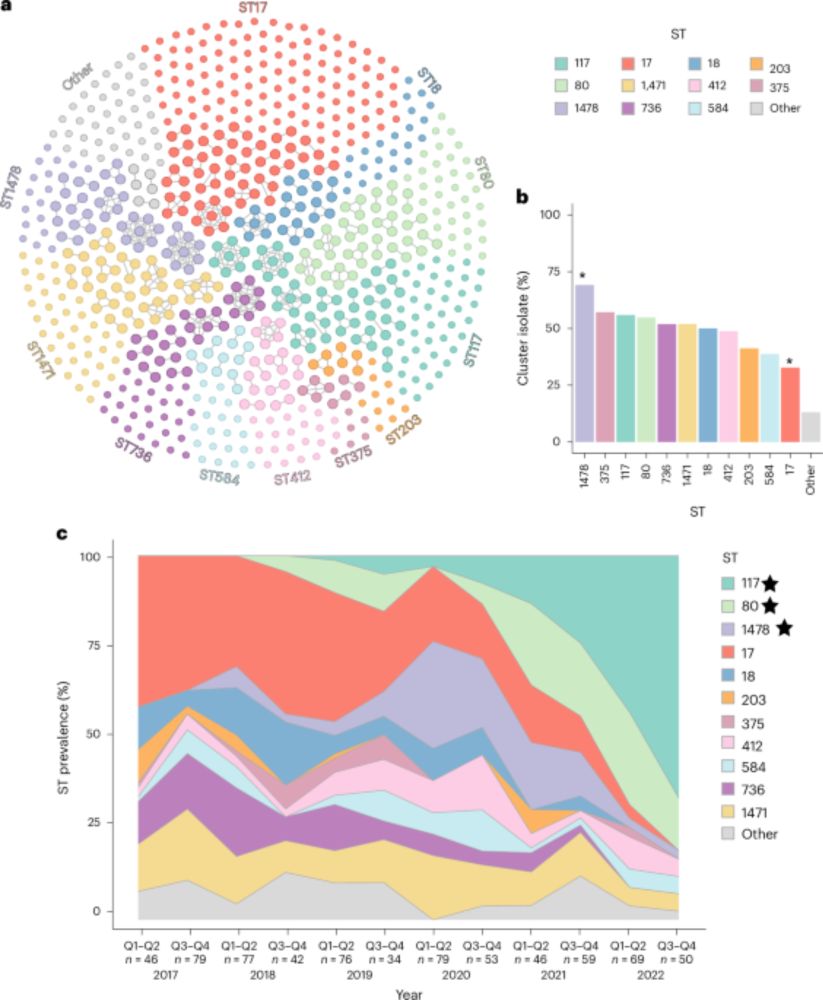
Bacteriocin production facilitates nosocomial emergence of vancomycin-resistant Enterococcus faecium - Nature Microbiology
Genomic and functional analyses of healthcare-associated vancomycin-resistant Enterococcus faecium reveal that bacteriocin T8 is enriched in emergent lineages and provides a competitive advantage in v...
www.nature.com
March 21, 2025 at 1:46 PM
Excited to share our latest, out today in @naturemicrobiol.bsky.social Bacteriocin production facilitates nosocomial emergence of vancomycin-resistant Enterococcus faecium www.nature.com/articles/s41... @idpittstop.bsky.social
Reposted by Mathilde Boumasmoud
Community stability is usually assessed by invading single species from rare and measuring relative fitness. However does this hold up when multiple species invade from rare? We test this using our super stable microbial community 👇🏻
Estimates of microbial community stability using relative invader growth rates are robust across levels of invader species richness
#ISMEComms by @mcastd.bsky.social, @padpadpadpad.bsky.social and Angus Buckling
academic.oup.com/ismecommun/a...
#ISMEComms by @mcastd.bsky.social, @padpadpadpad.bsky.social and Angus Buckling
academic.oup.com/ismecommun/a...

Estimates of microbial community stability using relative invader growth rates are robust across levels of invader species richness
Abstract. A key feature of natural communities is that the species within them stably coexist. A common metric used to test community stability is the abil
academic.oup.com
March 3, 2025 at 1:05 PM
Community stability is usually assessed by invading single species from rare and measuring relative fitness. However does this hold up when multiple species invade from rare? We test this using our super stable microbial community 👇🏻
Reposted by Mathilde Boumasmoud
New preprint is out!
We investigate how well you can call variants directly from genome assemblies compared to traditional read-based variant calling.
Read it here: www.biorxiv.org/content/10.1...
Data & code: github.com/rrwick/Are-r...
(1/8)
We investigate how well you can call variants directly from genome assemblies compared to traditional read-based variant calling.
Read it here: www.biorxiv.org/content/10.1...
Data & code: github.com/rrwick/Are-r...
(1/8)

Are reads required? High-precision variant calling from bacterial genome assemblies
Accurate nucleotide variant calling is essential in microbial genomics, particularly for outbreak tracking and phylogenetics. This study evaluates variant calls derived from genome assemblies compared...
www.biorxiv.org
March 3, 2025 at 3:24 AM
New preprint is out!
We investigate how well you can call variants directly from genome assemblies compared to traditional read-based variant calling.
Read it here: www.biorxiv.org/content/10.1...
Data & code: github.com/rrwick/Are-r...
(1/8)
We investigate how well you can call variants directly from genome assemblies compared to traditional read-based variant calling.
Read it here: www.biorxiv.org/content/10.1...
Data & code: github.com/rrwick/Are-r...
(1/8)
Reposted by Mathilde Boumasmoud
Congratulations to @emmiamueller.bsky.social on:
"Residence time structures microbial communities through niche partitioning"
Now out in Ecology Letters:
onlinelibrary.wiley.com/doi/10.1111/...
"Residence time structures microbial communities through niche partitioning"
Now out in Ecology Letters:
onlinelibrary.wiley.com/doi/10.1111/...

Residence Time Structures Microbial Communities Through Niche Partitioning
Much of life on earth is at the mercy of currents and flow. Residence time (τ) estimates how long organisms and resources remain in a system based on the ratio of volume (V) to flow rate (Q). We test...
onlinelibrary.wiley.com
February 27, 2025 at 3:06 PM
Congratulations to @emmiamueller.bsky.social on:
"Residence time structures microbial communities through niche partitioning"
Now out in Ecology Letters:
onlinelibrary.wiley.com/doi/10.1111/...
"Residence time structures microbial communities through niche partitioning"
Now out in Ecology Letters:
onlinelibrary.wiley.com/doi/10.1111/...
Reposted by Mathilde Boumasmoud
Roche's SBX sequencing by expansion - preprint out!
www.biorxiv.org/content/10.1...
www.biorxiv.org/content/10.1...

February 24, 2025 at 11:00 PM
Roche's SBX sequencing by expansion - preprint out!
www.biorxiv.org/content/10.1...
www.biorxiv.org/content/10.1...
Reposted by Mathilde Boumasmoud
The Oxford U. Foster and Slack labs are hiring! A chance to work in bleeding edge microbiome science with some really great mentors @mucosalimmunology.bsky.social
www.fosterlab.uk/vacancies
www.fosterlab.uk/vacancies
vacancies — Foster Lab
job vacancies in the Foster lab
www.fosterlab.uk
February 26, 2025 at 10:18 AM
The Oxford U. Foster and Slack labs are hiring! A chance to work in bleeding edge microbiome science with some really great mentors @mucosalimmunology.bsky.social
www.fosterlab.uk/vacancies
www.fosterlab.uk/vacancies
Reposted by Mathilde Boumasmoud
Two (!) perspective pieces published today involving people from our lab! @adelpanta.bsky.social on spatial patterning in microbial communities www.nature.com/articles/s41... and @salazarafra.bsky.social on microbial communities as evolutionary individuals www.sciencedirect.com/science/arti...
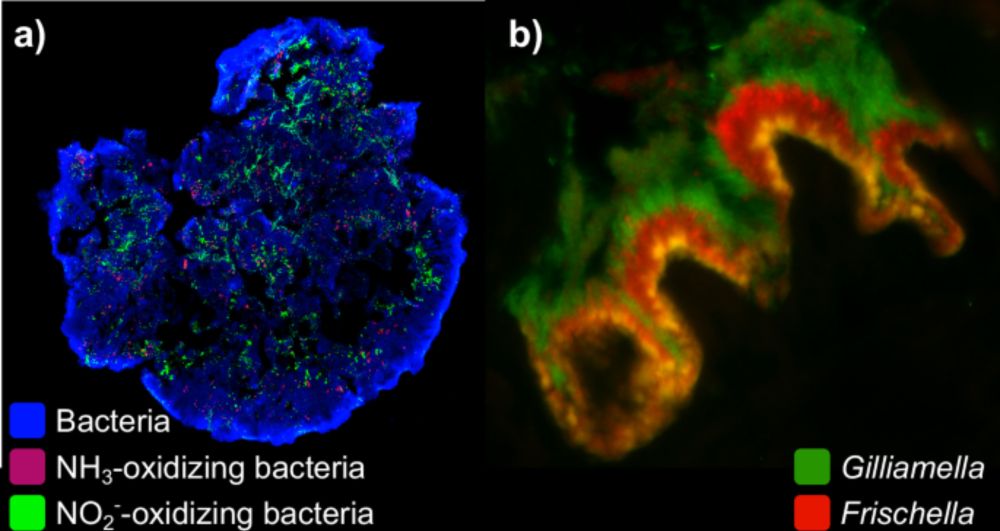
Disentangling the feedback loops driving spatial patterning in microbial communities - npj Biofilms and Microbiomes
npj Biofilms and Microbiomes - Disentangling the feedback loops driving spatial patterning in microbial communities
www.nature.com
February 20, 2025 at 2:41 PM
Two (!) perspective pieces published today involving people from our lab! @adelpanta.bsky.social on spatial patterning in microbial communities www.nature.com/articles/s41... and @salazarafra.bsky.social on microbial communities as evolutionary individuals www.sciencedirect.com/science/arti...
Reposted by Mathilde Boumasmoud
Really exciting work:
The Salmonella Colicin Col1b cannot only KILL a competing E. coli population, but also AMPLIFY metabolic contributions of susceptible bacteria by liberating β-gal…
From @nic-ler.bsky.social. @kroegerlab.bsky.social, Andrew Cameron and others ‼️
academic.oup.com/ismej/advanc...
The Salmonella Colicin Col1b cannot only KILL a competing E. coli population, but also AMPLIFY metabolic contributions of susceptible bacteria by liberating β-gal…
From @nic-ler.bsky.social. @kroegerlab.bsky.social, Andrew Cameron and others ‼️
academic.oup.com/ismej/advanc...

Lysis of Escherichia coli by colicin Ib contributes to bacterial cross-feeding by releasing active β-galactosidase
Abstract. The diffusible toxin ColIb produced by Salmonella enterica serovar Typhimurium SL1344 is a potent inhibitor of Escherichia coli growth. To identi
academic.oup.com
February 23, 2025 at 12:07 PM
Really exciting work:
The Salmonella Colicin Col1b cannot only KILL a competing E. coli population, but also AMPLIFY metabolic contributions of susceptible bacteria by liberating β-gal…
From @nic-ler.bsky.social. @kroegerlab.bsky.social, Andrew Cameron and others ‼️
academic.oup.com/ismej/advanc...
The Salmonella Colicin Col1b cannot only KILL a competing E. coli population, but also AMPLIFY metabolic contributions of susceptible bacteria by liberating β-gal…
From @nic-ler.bsky.social. @kroegerlab.bsky.social, Andrew Cameron and others ‼️
academic.oup.com/ismej/advanc...

